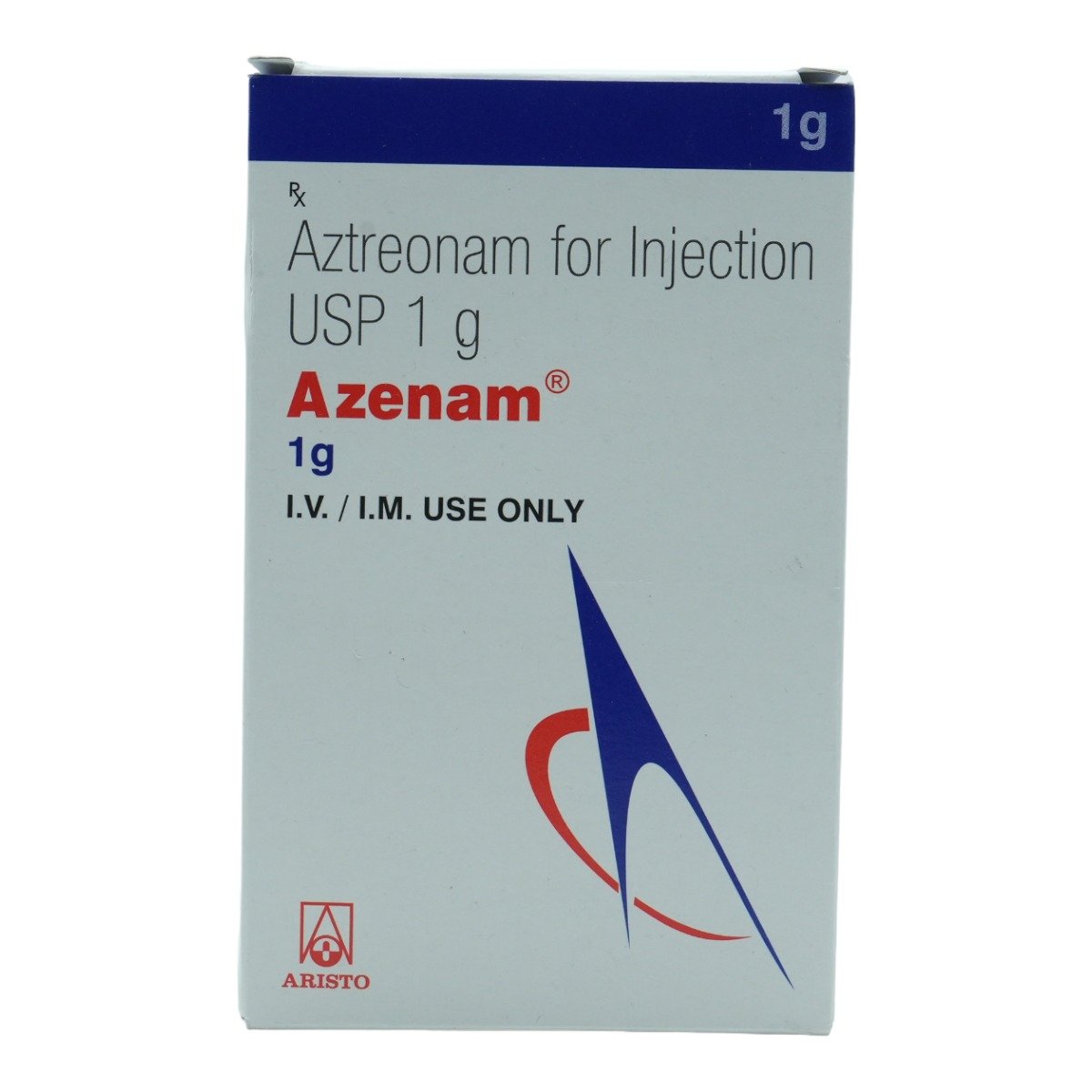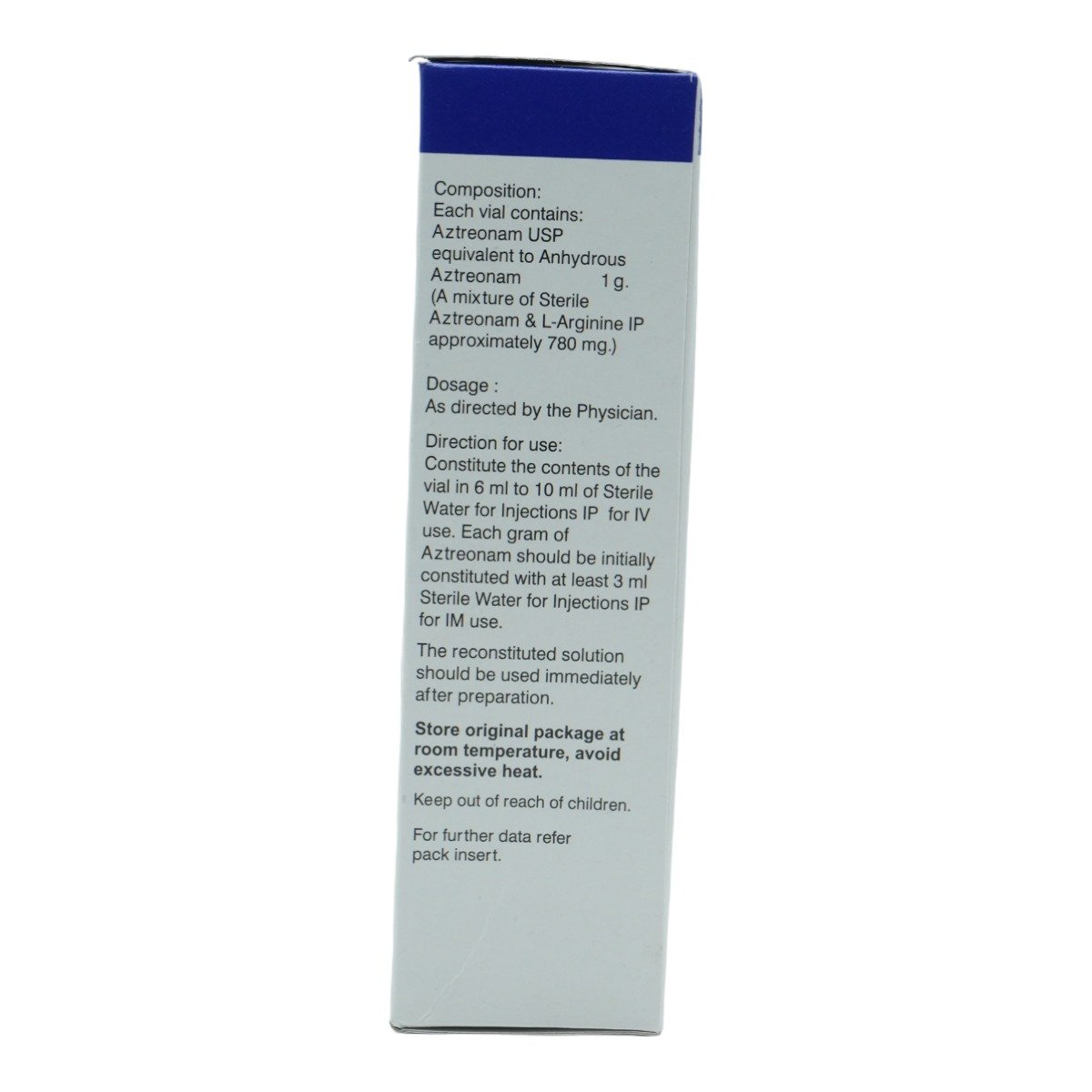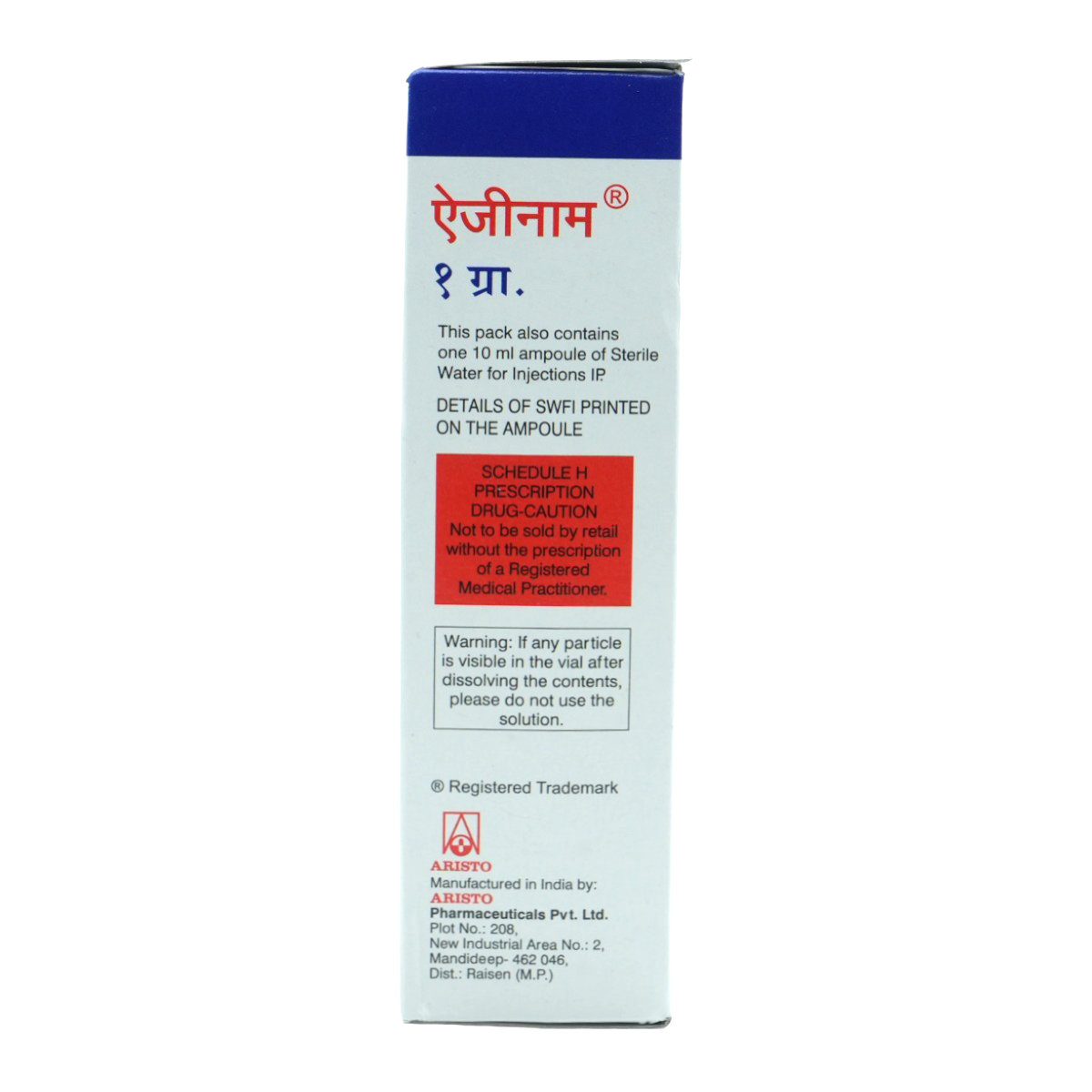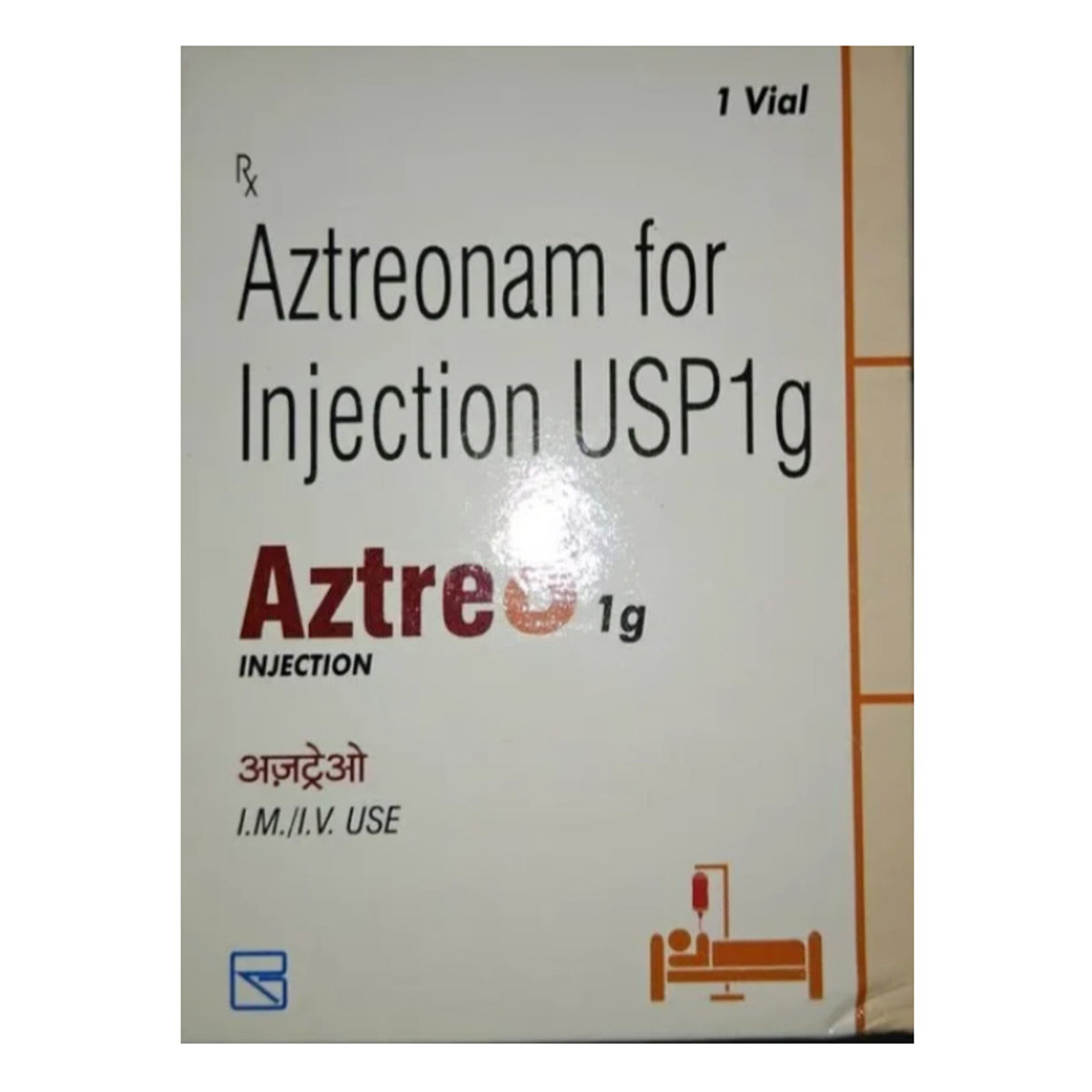Azenam 1 gm Injection




MRP ₹841.5
(Inclusive of all Taxes)
₹126.2 Cashback (15%)
know your delivery time
Provide Delivery Location
Composition :
Manufacturer/Marketer :
Consume Type :
Expires on or after :
Return Policy :

Secure Payment

Trusted by 8 Crore Indians

Genuine Products
Therapeutic Class
Country of origin
Manufacturer/Marketer address
Disclaimer
Alcohol
Safe if prescribed
The interaction of alcohol with Azenam 1 gm Injection is unknown. Please consult a doctor before consuming alcohol while using Azenam 1 gm Injection.
Pregnancy
Consult your doctor
The safety of Azenam 1 gm Injection in pregnant women is unknown. Therefore, it is given to pregnant women only if the doctor thinks the benefits outweigh the risks.
Breast Feeding
Consult your doctor
Azenam 1 gm Injection is excreted in human milk. Therefore, it is given to breastfeeding mothers only if the doctor thinks benefits are greater than risks.
Driving
Safe if prescribed
Azenam 1 gm Injection cause double vision, dizziness as a side effect. So, avoid driving after receiving Azenam 1 gm Injection.
Liver
Consult your doctor
Take Azenam 1 gm Injection with caution, especially if you have a history of Liver diseases/conditions. The dose may be adjusted by your doctor as required.
Kidney
Consult your doctor
Take Azenam 1 gm Injection with caution, especially if you have a history of Kidney diseases/conditions. The dose may be adjusted by your doctor as required.
Children
Safe if prescribed
Azenam 1 gm Injection can be given safely to children, dose to be adjusted and recommended by a child specialist only.
Product Substitutes
About Azenam 1 gm Injection
Azenam 1 gm Injection belongs to a class of antibiotics used in the treatment of serious bacterial infections. A bacterial infection is a condition in which harmful bacteria grows in the body and causes infection. It can infect any part of the body and multiple very quickly.
Azenam 1 gm Injection contains aztreonam, which belongs to a class of monobactam antibiotics. It works by inhibiting the formation of the bacterial cell wall (a protective covering) that is necessary for their survival.
Some common side effects of Azenam 1 gm Injection include dizziness, bad breath, headache, sneezing, high temperature, bleeding of the stomach, double vision. These side effects are not familiar to everyone and vary individually. If you notice any side effects that are not manageable, please consult your doctor.
If you are known to be allergic to Azenam 1 gm Injection or any other medicines, please tell your doctor. Do not receive Azenam 1 gm Injection if you are pregnant or breastfeeding. Consult your doctor immediately if you notice signs of allergic reaction such as swelling of the face, lips, throat, and/or tongue with difficulty in breathing after receiving Azenam 1 gm Injection.
Uses of Azenam 1 gm Injection
Medicinal Benefits Mweb
Key Benefits
Azenam 1 gm Injection belongs to the class of monobactam antibiotics. It reduces the infection by inhibiting bacterial growth. It kills the bacteria by disrupting the formation of the cell wall. It irreversibly binds to the proteins in the bacteria that are essential for the formation of the cell membrane.
Directions for Use
Side Effects of Azenam 1 gm Injection
- Dizziness
- Chest pain
- Headache
- Double vision
- Bad breath
- Vaginal irritation
- Blocked nose
Drug Warnings
Regular monitoring of kidney and liver functioning is recommended while taking Azenam 1 gm Injection. If you are a breastfeeding or pregnant woman, please consult a doctor before taking Azenam 1 gm Injection. If you notice blood in stools or have severe stomach pain with diarrhoea, contact your doctor immediately. Inform your doctor before taking Azenam 1 gm Injection if you have liver problems, kidney problems, blood disorders, fits. Also, inform your doctor if you are already taking medicines like antibiotics or oral anticoagulants.
Drug-Drug Interactions
Drug-Drug Interactions
Login/Sign Up
Coadministration of Azenam 1 gm Injection with Cholera vaccine can reduce the effects of Cholera vaccine.
How to manage the interaction:
Taking Azenam 1 gm Injection with Cholera vaccine together can result in an interaction, but it can be taken if your doctor has advised it. Do not stop using any medications without first talking to your doctor.
When BCG vaccine is used together with Azenam 1 gm Injection, its effectiveness may be reduced.
How to manage the interaction:
There may be a possibility of interaction between Azenam 1 gm Injection and BCG vaccine, but it can be taken if prescribed by a doctor. Do not stop using any medications without first talking to your doctor.
Drug-Food Interactions
Drug-Food Interactions
Login/Sign Up
Drug-Diseases Interactions
Drug-Diseases Interactions
Login/Sign Up
Drug-Drug Interactions Checker List
- WARFARIN
- ENTECAVIR
- CHOLERA VACCINE
- PEMETREXED
- DICUMAROL
Habit Forming
Diet & Lifestyle Advise
- Take probiotics after completing the full course of Azenam 1 gm Injection to restore some healthy bacteria in the intestines that may have been killed. Taking probiotics after antibiotic treatment can reduce the risk of antibiotic-associated diarrhoea. Certain fermented foods like cheese, yoghurt, kombucha, sauerkraut and kimchi can help to restore the good bacteria of the intestine.
- Include fibre rich foods, as they can be easily digested by your gut bacteria, which helps stimulate their growth. Thus, fibre rich foods may help restore healthy gut bacteria after a course of antibiotics. Whole grains such as whole-grain bread, brown rice should be included in your diet.
- Make sure you drink plenty of water or other fluids every day while you are taking Azenam 1 gm Injection.
All Substitutes & Brand Comparisons
RX
Out of StockReonam 1gm Injection
Unimark Remedies Ltd
₹423.07
(₹380.76 per unit)
49% CHEAPERRX
Out of StockDruzem 1gm Injection
Drukst Biotech Pvt Ltd
₹425
(₹382.5 per unit)
49% CHEAPERRX
Out of StockLimonam 1gm Injection
Ancalima Lifesciences Ltd
₹450
(₹405.0 per unit)
46% CHEAPER

Have a query?
Buy best Infections & Infestation products by
Cipla Ltd
Macleods Pharmaceuticals Ltd
Alkem Laboratories Ltd
Lupin Ltd
Abbott India Ltd
Sun Pharmaceutical Industries Ltd
Mankind Pharma Pvt Ltd
Micro Labs Ltd
Aristo Pharmaceuticals Pvt Ltd
FDC Ltd
Intas Pharmaceuticals Ltd
Glenmark Pharmaceuticals Ltd
Ipca Laboratories Ltd
Torrent Pharmaceuticals Ltd
Zydus Healthcare Ltd
Biochem Pharmaceutical Industries Ltd
Zuventus Healthcare Ltd
United Biotech Pvt Ltd
Hetero Drugs Ltd
Emcure Pharmaceuticals Ltd
Alembic Pharmaceuticals Ltd
Indoco Remedies Ltd
Fusion Health Care Pvt Ltd
Dr Reddy's Laboratories Ltd
Leeford Healthcare Ltd
Cadila Healthcare Ltd
Wockhardt Ltd
Zydus Cadila
GlaxoSmithKline Pharmaceuticals Ltd
Morepen Laboratories Ltd
Blue Cross Laboratories Pvt Ltd
Cadila Pharmaceuticals Ltd
Converge Biotech Pvt Ltd
Elder Pharmaceuticals Ltd
Hetero Healthcare Pvt Ltd
Pfizer Ltd
AAA Pharma Trade Pvt Ltd
Gufic Bioscience Ltd
Mylan Pharmaceuticals Pvt Ltd
Corona Remedies Pvt Ltd
Wallace Pharmaceuticals Pvt Ltd
Apex Laboratories Pvt Ltd
Medishri Healthcare Pvt Ltd
Akumentis Healthcare Ltd
Alniche Life Sciences Pvt Ltd
Hegde & Hegde Pharmaceutica Llp
Veritaz Healthcare Ltd
Ranbaxy Laboratories Ltd
Koye Pharmaceuticals Pvt Ltd
Shreya Life Sciences Pvt Ltd
Overseas Health Care Pvt Ltd
Biocon Ltd
Indchemie Health Specialities Pvt Ltd
Medley Pharmaceuticals Ltd
Brinton Pharmaceuticals Ltd
J B Chemicals & Pharmaceuticals Ltd
Unifaith Biotech Pvt Ltd
Ajanta Pharma Ltd
Biochemix Health Care Pvt Ltd
Natco Pharma Ltd
Samarth Life Sciences Pvt Ltd
Unichem International
Laborate Pharmaceuticals India Ltd
Unipark Biotech Pvt Ltd
Zymes Bioscience Pvt Ltd
Indiabulls Pharmaceuticals Pvt Ltd
Neon Laboratories Ltd
Vasu Organics Pvt Ltd
DR Johns Lab Pharma Pvt Ltd
East West Pharma India Pvt Ltd
La Renon Healthcare Pvt Ltd
Medgen Drugs And Laboratories Pvt Ltd
Novartis India Ltd
Canixa Life Sciences Pvt Ltd
Icarus Health Care Pvt Ltd
Lincoln Pharmaceuticals Ltd
Celon Laboratories Pvt Ltd
Concept Pharmaceuticals Ltd
Klm Laboratories Pvt Ltd
Nicholas Piramal India Ltd
Systopic Laboratories Pvt Ltd
Yuventis Pharmaceuticals
Capital Pharma
German Remedies Ltd
Pristine Pearl Pharma Pvt Ltd
Unison Pharmaceuticals Pvt Ltd
Aurz Pharmaceutical Pvt Ltd
Clover Health Care Pharma
Kepler Healthcare Pvt Ltd
Allites Life Sciences Pvt Ltd
Auspharma Pvt Ltd
Intra Life Pvt Ltd
Jolly Healthcare
Linux Laboratories Pvt Ltd
Ozone Pharmaceuticals Ltd
Cachet Pharmaceuticals Pvt Ltd
Comed Chemicals Ltd
Delcure Life Sciences Ltd
Fresenius Kabi India Pvt Ltd
Khandelwal Laboratories Pvt Ltd
Frequently Bought Together
₹101.1
MRP ₹121.5
17% off
1
+






